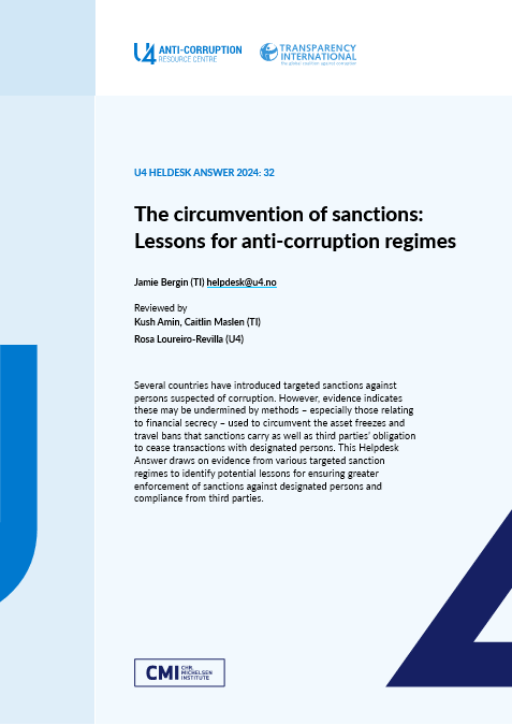
This Anti-Corruption Helpdesk brief was produced in response to a query from a U4 Partner Agency. The U4 Helpdesk is operated by Transparency International in collaboration with the U4 Anti-Corruption Resource Centre based at the Chr. Michelsen Institute.
Query
Please describe how the circumvention of anti-corruption sanctions occurs and what measures can be taken against it.
Summary
Several countries have introduced targeted sanctions against persons suspected of corruption. However, evidence indicates these may be undermined by methods – especially those relating to financial secrecy – used to circumvent the asset freezes and travel bans that sanctions carry as well as third parties’ obligation to cease transactions with designated persons. This Helpdesk Answer draws on evidence from various targeted sanction regimes to identify potential lessons for ensuring greater enforcement of sanctions against designated persons and compliance from third parties.
Main points
- There is a growing literature on the use of targeted, Magnitsky style sanctions against corrupt actors, but the circumvention or evasion of these is an understudied aspect.
- The existing anti-corruption regimes penalise circumvention, but existing data on enforcement and the rate of circumvention is limited.
- Anecdotal evidence, however, indicates that designated persons may make use of several circumvention methods analogous to those used for money laundering in order to overcome asset freezes and travel bans entailed by sanctions.
- They are typically assisted by ‘enablers’, professional third parties, such as wealth managers, who provide these methods as a service. Other third parties may also wittingly or unwittingly continue to transact with a designated person, violating the sanction and their obligation to carry out due diligence on clients.
- The causes of circumvention include a lack of investment in enforcement, insufficient international coordination across jurisdictions, challenges faced in sanctions screening and the abuse of financial secrecy rules, especially in so-called circumvention hubs.
- The literature, especially pertaining to other sanctions regimes, identifies potential measures to address these causes and counter these methods. These include: investing in institutional capacity to enforce compliance with sanctions; strengthening beneficial ownership and asset transparency laws; and promoting international cooperation.
- Some measures take a punitive, deterrent approach, such as extending the primary sanction to family members of the designated person or introducing robust penalties or even secondary sanctions against enablers. Several commentators stress these should align with legal safeguards.
- Other measures take a more incentive based approach with, for example, the state more proactively supporting companies to fulfil their legal obligation to carry out due diligence and sanctions screening, including using timely information and technology opportunities.
Authors
Jamie Bergin (TI) [email protected]
Reviewers
Kush Amin, Caitlin Maslen (TI)
Rosa Loureiro-Revilla (U4)
Date
19/08/2024

